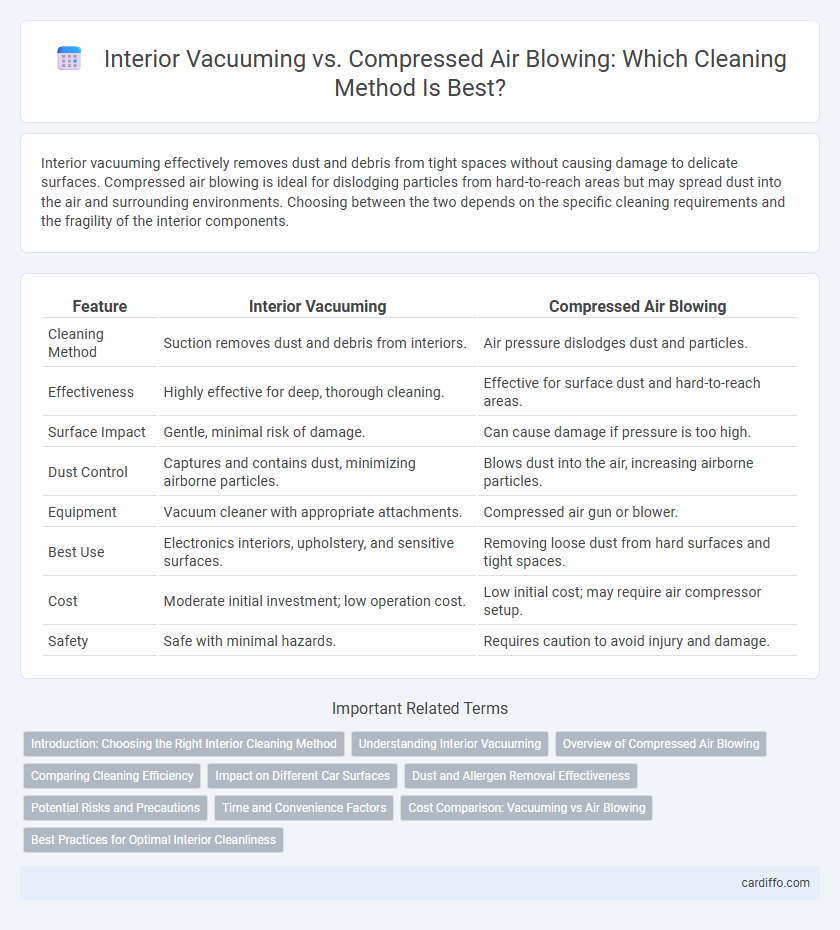Interior vacuuming effectively removes dust and debris from tight spaces without causing damage to delicate surfaces. Compressed air blowing is ideal for dislodging particles from hard-to-reach areas but may spread dust into the air and surrounding environments. Choosing between the two depends on the specific cleaning requirements and the fragility of the interior components.
Table of Comparison
| Feature | Interior Vacuuming | Compressed Air Blowing |
|---|---|---|
| Cleaning Method | Suction removes dust and debris from interiors. | Air pressure dislodges dust and particles. |
| Effectiveness | Highly effective for deep, thorough cleaning. | Effective for surface dust and hard-to-reach areas. |
| Surface Impact | Gentle, minimal risk of damage. | Can cause damage if pressure is too high. |
| Dust Control | Captures and contains dust, minimizing airborne particles. | Blows dust into the air, increasing airborne particles. |
| Equipment | Vacuum cleaner with appropriate attachments. | Compressed air gun or blower. |
| Best Use | Electronics interiors, upholstery, and sensitive surfaces. | Removing loose dust from hard surfaces and tight spaces. |
| Cost | Moderate initial investment; low operation cost. | Low initial cost; may require air compressor setup. |
| Safety | Safe with minimal hazards. | Requires caution to avoid injury and damage. |
Introduction: Choosing the Right Interior Cleaning Method
Interior vacuuming efficiently removes dust and debris from carpets, upholstery, and vents by suctioning particles into a bag or container, ensuring thorough cleaning without dispersing contaminants. Compressed air blowing effectively dislodges fine dust and debris from hard-to-reach areas like electronic components, crevices, and vents by propelling air at high velocity to push contaminants outward. Selecting the appropriate method depends on the surface type, desired cleanliness level, and whether containment or displacement of dust is preferable.
Understanding Interior Vacuuming
Interior vacuuming effectively removes dust, debris, and allergens from car seats, carpets, and crevices using powerful suction and specialized attachments. This method preserves delicate surfaces while ensuring deep cleaning, reducing the risk of damage compared to compressed air blowing. Regular vacuuming maintains indoor air quality by eliminating particles that compressed air can disperse into the environment.
Overview of Compressed Air Blowing
Compressed air blowing is an effective cleaning method that uses high-pressure air to dislodge dust, debris, and particles from hard-to-reach interior surfaces, especially in electronic devices and machinery. Unlike interior vacuuming, which relies on suction, compressed air blowing reaches intricate crevices without physical contact, reducing the risk of damaging delicate components. This technique is favored in environments requiring precision cleaning, such as computer hardware maintenance and automotive detailing.
Comparing Cleaning Efficiency
Interior vacuuming effectively removes dust, debris, and allergens from surfaces and tight spaces using suction power, providing thorough cleanliness without dispersing particles into the air. Compressed air blowing, while quick for dislodging loose dirt and debris from hard-to-reach areas, can aerosolize contaminants, potentially spreading dust rather than eliminating it. Vacuuming demonstrates higher cleaning efficiency by capturing and containing particles, making it preferable for maintaining indoor air quality and comprehensive interior cleanliness.
Impact on Different Car Surfaces
Interior vacuuming effectively removes dust, dirt, and debris from soft surfaces like carpets and fabric seats without causing damage, preserving material integrity. Compressed air blowing is more suitable for hard-to-reach crevices and dashboards but can risk dislodging fragile elements or pushing dirt deeper into porous surfaces. Selecting the right method depends on the specific car surface to maintain cleanliness while preventing abrasion or surface wear.
Dust and Allergen Removal Effectiveness
Interior vacuuming effectively captures dust and allergens by suctioning particles into high-efficiency particulate air (HEPA) filters, reducing airborne contaminants and improving indoor air quality. Compressed air blowing dislodges dust from surfaces and crevices but can disperse fine allergens into the air, potentially worsening respiratory issues if not followed by proper filtration. Combining vacuuming with compressed air in hard-to-reach areas enhances thorough dust and allergen removal, ensuring a cleaner and healthier indoor environment.
Potential Risks and Precautions
Interior vacuuming minimizes dust dispersal and reduces allergen exposure, making it safer for sensitive environments compared to compressed air blowing. Compressed air blowing can force debris into hard-to-reach areas or damage delicate components, increasing the risk of respiratory issues and surface harm. Using proper protective gear and ensuring adequate ventilation are essential precautions when employing compressed air for interior cleaning.
Time and Convenience Factors
Interior vacuuming offers a thorough cleaning by effectively removing dust and debris from tight spaces, but it can be time-consuming and requires access to power sources and vacuum equipment. Compressed air blowing provides a faster alternative for dislodging dust and particles in hard-to-reach areas without direct contact, increasing convenience but potentially leaving some residue behind. Choosing between these methods depends on balancing the need for thoroughness with available time and the ease of use in specific cleaning scenarios.
Cost Comparison: Vacuuming vs Air Blowing
Interior vacuuming typically incurs higher initial costs due to equipment investment and maintenance but offers long-term savings through energy efficiency and reduced cleaning time. Compressed air blowing has lower upfront expenses but leads to increased operational costs from higher energy consumption and frequent tool replacements. Evaluating total cost of ownership reveals vacuuming as a more economical option for sustained interior cleaning applications.
Best Practices for Optimal Interior Cleanliness
Interior vacuuming effectively removes dust, dirt, and allergens from surfaces and crevices, ensuring a thorough clean without dispersing debris. Compressed air blowing is best suited for loosening particles from hard-to-reach areas but should be followed by vacuuming to capture disturbed dust. Optimal interior cleanliness is achieved by combining both methods strategically to maximize debris removal while minimizing airborne contaminants.
Interior Vacuuming vs Compressed Air Blowing Infographic

 cardiffo.com
cardiffo.com